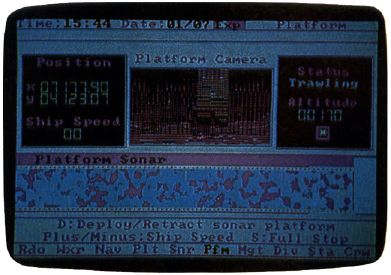SEARCH FOR THE TITANIC
You've flown a military jet, managed a baseball team, raced a Porsche on the Autobahn, and led your country into war—without leaving the safety of your computer room. Now you can sink to new depths with Search for the Titanic.
Shipwrecks have a fascinatingly mysterious quality. What you find when you dive on a wreck is intriguing, addicting, and terrifying. And the most fascinating wreck of all is the Titanic.
Capstone's Search for the Titanic not only provides hours of oceanographic adventure, but also does a good job of explaining how the ship was found. Dr. Robert Ballard, the leader of the expedition that discovered the great liner four years ago, spent enormous sums of money achieving his goal. Once you've played this game, you'll understand why he needed it all.

In Search for the Titanic, you must get together the money for a series of discovery expeditions, then equip your expedition and sail to the site of the wreck. There, you must coordinate your divers and equipment as you explore sunken vessels.
There is a mini-game in which you search only for the Titanic, but the real challenge lies in the full game, where 77 wrecks wait to be found. You begin with only $10,000, with which you must rent a ship, hire a crew and divers, and buy fuel and provisions before you can look for a wreck. When you find one, dive to it and then return to port to improve your reputation. An improved reputation means a greater chance of securing funding for future expeditions, which in turn yield an even better reputation. You're in this business for excitement and glory, but your sponsors want something more.
Four types of ship are available for rent or purchase, ranging from the lowly $50,000 Moyu to the $600,00 Voyager. You can start your expedition from over 40 different ports around the world, each one rated according to technical level, important for repairs and equipment availability. Planning includes getting your ship and choosing a starting port, then hiring your captain, doctor, navigator, mechanic, technicians, and divers. Each of these people gets paid by the day, and the more experienced they are, the more they'll cost you.
You must also buy equipment. At first, you can't afford any, which means you will only be able to scuba dive on shallow wrecks. Later, you'll want to consider purchasing items like a magnetometer ($10,000), platform sonar ($80,000), weather radar ($10,000), and minisub ($750,000). Because all your initial money is needed to rent a ship, buy supplies, and hire a crew, this equipment is completely out of reach until later in the game.
After choosing a wreck to search for, then getting your plan evaluated and finding funding, you're ready to head to sea. In Navigation mode, you guide your ship to the approximate coordinates displayed on the wreck chart. Once close to the site, switch to Exploration mode and zero your ship in on the target. When you're close, stop the ship and send down the divers.
Two divers go down at a time, spend some time on the bottom, then resurface and tell you what they've found. First you have them survey; then, when they've found the wreck, you send them down to explore it. You can view a digitized picture of what they find. These photographs are especially exciting when you find the Titanic; VGA owners are treated to some spectacular photos of the actual wreck.
If the wreck is below scubadiving depth, you'll need advanced equipment just to find it. The magnetometer will locate large pieces of metal lying on the ocean floor. Ship sonar, deep sonar, and platform sonar return information about water depth, revealing possible wreck locations. You need all three to fully cover the varied ocean depths. Once you know where the wreck is, you can send down your minisub or bathysphere to explore the sunken ship and bring back artifacts and treasures.
A command you'll definitely want to use when playing Search for the Titanic is ALT-W, which toggles warp speed on and off. Warp speed changes the game from realtime to accelerated time. Without it, the game would be unplayable because all of the diving and exploring would, in real-time, take hundreds of hours.
Search for the Titanic is an extremely educational game. You'll learn what it takes to find a sunken ship, and you'll begin to appreciate the enormous financial commitment needed to make such discoveries. Finding shipwrecks is something few of us will ever get to do. This excellent simulation will expand your port of call beyond the computer room.
—NEIL RANDALL
|
IBM PC and compatibles—$39.95 CAPSTONE |